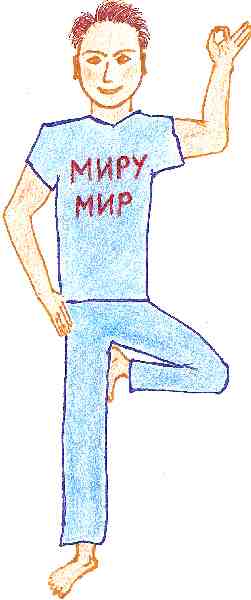Yoga Meditation
This is it...
Yoga meditation is what this whole system of yoga is all about.
Meditation means FOCUSED THOUGHT. It is a steady, unwavering focus toward one thought for a specific period of time.
Meditation is NOT thinking; and it is NOT focusing, or concentrating.
Yoga meditation implies that your mind is already focused on ONE thought. It means Perfect Concentration.
Yoga meditation uses techniques common in the system of yoga (as opposed to other meditation traditions such as Buddhism).
When the mind is perfectly focused on ONE thing, there's no mental noise, chatter, or confusion.

There are no thoughts.
There's only one thought - your meditation technique.
No stress occurs.
No tension accumulates.
No worries present.
No pain felt.
The meditator experiences the feeling of inner harmony and well-being. The mind is harmonized with a healing meditation technique, and the body responds with physical harmony.
With regular meditation practice, before you even get to this ONE-POINTED focus, you'll begin to notice a lot of positive changes in your life.
Don't be surprised to want to switch to a more meaningful career, or start exploring other ways to improve your health.
Beyond Meditation
At some point during the one-pointed meditative focus, a curious thing occurs: The one remaining thought of the meditation itself gets dropped. Naturally and spontaneously.
Then, you become free from the mind.
If only for that moment. Free from the binds of time and space and any physical limitations.
You transcend the physical reality, and experience the state of SAMADHI.
SAMADHI is the ultimate goal of yoga.
SAMADHI is equivalent to Enlightenment. Yoga meditation is the vehicle that takes you there.
Meditation is Preparation for SAMADHI.

Interesting Fact: Meditation and SAMADHI are at opposite poles of the same spectrum. Yoga meditation is extreme one-pointedness of mind. SAMADHI is extreme dis-identification from the mind (no focus on any one thing, but every thing at once).
Yogi Mir's Secret: Scroll down to the bottom to see it.
There are no SAMADHI techniques. Only meditation techniques.
So before we get to SAMADHI, we must train the mind to be in our control.
We have to be able to focus the mind on one thing for an extended period.
We have to learn to enjoy the process of concentration, the step that precedes the one-pointed meditative state.
Healthy Habit # Establish a daily yoga meditation/concentration practice.
Preparation:
1. Find a good time of day with little distractions. Maybe in the morning before breakfast, or at night before bed when kids are asleep.
2. Be realistic. Start with 10 minutes.
3. Have a meditation journal. Write down what you focused on and how you felt.
Step ONE: Begin with sitting comfortably: in a chair, or a cushion. Lean against a wall if you wish. It's best to sit up, without lying down. Why? Because you want to remain alert. When your body is horizontal, the brain receives the messages from the nervous system to release the 'sleep' hormones.
Step TWO: Become aware of your breath. Witness the breath without control at first. Then, naturally, encourage it to lengthen and deepen.
Up until this point, this is already a wonderful practice - just get it going on a regular basis.
Step THREE: Pick your focus. It MUST BE uplifting, interesting to your mind, and very specific. Your mind will get distracted. That's OK. It's natural to be distracted. Gently, without tension or force, bring the mind back to your focusing technique. Over and over and over ...
Common Yoga Meditation Techniques
~ focus on body awareness ~
~ focus on the breath flow ~
~ focus on a healing image ~
~ focus on a healing sound vibration, i.e. Mantra ~
~ focus on a positive feeling like Love that you feel for your child, or parent ~
Contact Yogi Mir for more personalized yoga meditation instruction.
The Spiritual Stepladder
Concentration precedes meditation, and meditation leads to SAMADHI.
There are Eight Steps in total.
In Sanskrit, "Eight Steps" are "Ashta Anga". Hence, the term "Ashtanga Yoga".
1. Yama, rules of social conduct (go to Yoga Lifestyle for more details);
2. Niyama, rules of personal conduct;
3. Asana, steady and comfortable posture achieved through regular practice;
4. Pranayama, control of energy though breath, energy locks, and visualization;
5. Pratyahara, withdrawal from sensory distractions;
6. Dharana, concentration!
7. Dhyana, yoga meditation!
8. SAMADHI
See, it's a natural step-by-step progression. Yoga is a science, after all, with you as the scientist and the explorer.
Yogi Mir's Secret About SAMADHI

Relax. You are already there.
You are what you are searching for.
SAMADHI is our true nature.
SAMADHI is a natural state of being that all of us have experienced many times.
The mind works as a veil and distracts us from knowing this truth.
The reason to practice yoga meditation is not to reach SAMADHI, but to work with the mind, to control the mind, and to thin the veil that keeps us from seeing the truth.
|